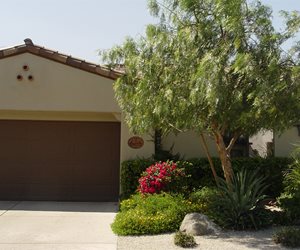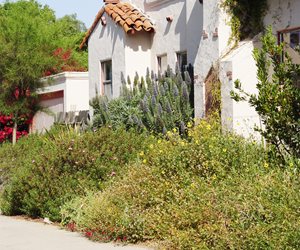Foundation Watering and Landscaping
How landscaping can help prevent cracks in your patio slab or home foundation
Landscaping around a foundation helps keep adequate moisture in the soils which can help reduce foundation cracking.
If you live in an area with clay soils and dry weather, the elements are primed to cause movement in your foundation slab. Homeowners in North Texas and East Texas have reportedly been most affected with noticeable cracks in the brick veneers and facing of their homes. The high clay content in the base soils of these areas is susceptible to expanding and contracting movement due to either very dry or very wet climate changes. Many people, unfortunately, do not realize the impact the environment can have on what appears to be a very stable home foundation.
Watering a foundation is a critical to mitigating cracks. Although it's impossible to control the amount of rainfall in an area, you can control the balance of moisture around the foundation during dry periods. The soil next to and under the foundation needs to remain at a constant moisture level. This helps to stabilize the movement a foundation experiences when high clay soils expand when they're overly saturated and contract when they're extremely dry.

It's best to water a foundation a minimum of 24" away from the foundation, which makes prime landscaping opportunities with flower beds and foundation shrubs.
How to Properly Water a Foundation
Starting a watering program is not as effective if started once cracks are noticeable in the foundation or walls of the home. In many cases, homeowners don't recognize the need for starting a foundation watering maintenance program. A foundation needs to be maintained and watering throughout the year is the best program. Luckily, watering a foundation is not an overly expensive or time-consuming event.
The best solution is to use a soaker hose which should be laid around the perimeter of the foundation slab. The hose should be used a minimum of 24" away from the foundation. Do not place the soaker hose directly against the slab as it can erode the base soil. Setting up an electric timer can help make the foundation watering process more efficient and continuous. The timer should be set to keep the soil moist for at least 3-5ft in depth. Watering should also be done around the entire perimeter. Oftentimes, the front of the house is kept moist through front yard watering, however backyards are more dry which causes unevenness in the soils around the perimeter of the house.
Foundation Landscaping
Luckily, many homes incorporate flower beds and foundation shrubs as greenery at the base of the home. This foundation landscaping helps to keep adequate moisture near the house which, in turn, keeps moisture levels more constant. Trees are an exception, which tend to extract moisture from the soil, especially trees with shallow root systems. The Department of Housing and Urban Development suggests trees be planted no closer than their ultimate height, according to a statement aboutmaintaining a foundationfrom Foundation Repair Network.
A homeowner's best efforts can really be in early detection, according to writer Kathleen Phillips atFoundationWatering.com. Examine the walls, windows and doors of your home for warning signs of expansion joint separation, cracking exteriors, diagonal cracks near windows or doors, improperly closing doors that seem to jam, etc.
If you suspect problems in your foundation, getfoundation repair informationfrom ConcreteNetwork.com.

 Backyards
Backyards
 Front Yards
Front Yards









